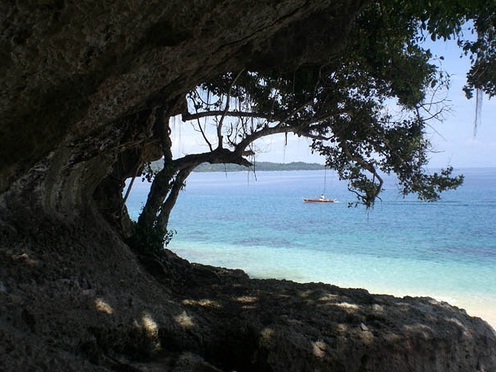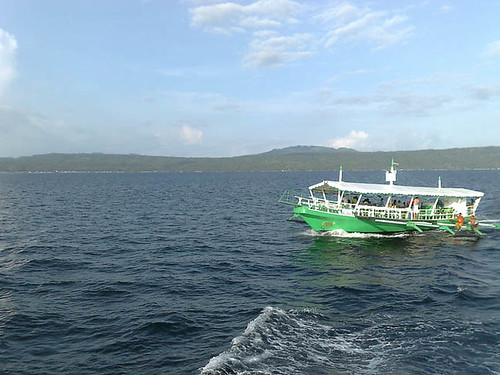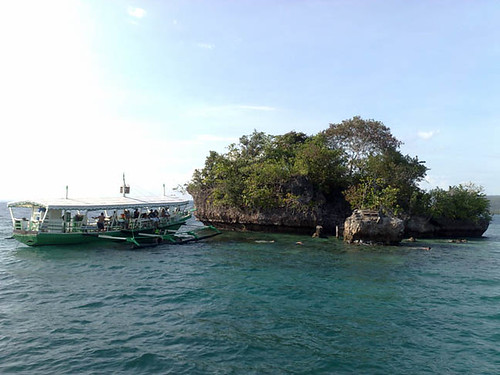I will be providing Island-hopping information, tips, reminders, maps and costing guides—things that aren’t easy to find on the Web. I hope this could be of help to readers or their friends who are planning to embark on an adventure cruise in and around the Davao Gulf.
Commercial Island-Hopping Packages. For a maximum of convenience, contact any of Davao and Samal’s Travel and Tour Agencies, Resorts and Hotels for offerings. Standard Island-Hopping tours already include full-day (8-hour) boat rentals, a tour guide, individually packed lunch, complimentary bottled water, the standard 5 sets of snorkeling gears, and one kayak or banca (oar-driven mini-boat). These packages take you to at least three major stopover points and normally cruise on the Western Davao Gulf area—the part closer to Davao City. Rates usually start at Php 15,000 (USD 366) for 20 persons. Prices can go up or down depending on the number of passengers.
Customized Island-Hopping Package. Island-hopping doesn’t have to be costly. The budget-conscious can do away with the kayak and the tour guide. After all, the boat captain and crew know every nook and cranny of the Davao Gulf like any seasoned Tour guide. And, most of the larger boats come equipped with a banca or mini-boat so that pretty much steps in for the kayak. Head over to the Sta. Ana wharf beside the Magsaysay Park in Downtown Davao and make a selection among the many boats docked thereat. Plan your route and destinations. Also, plan your meals ahead of time. Here are the things to consider in customizing your Island-hopping experience:
Boat Rentals. The Sta. Ana wharf is host to Davao’s island-hopping boats. Go to the wharf at most one day before the scheduled tour date and take your pick among the launches docked in the area and make arrangements with the boat owners or crew. A 30 to 40-capacity boat will cost you around Php 4,000 to Php 6,000 (USD 98 to USD 147). A 90-seater will cost around Php 9,000 (USD 220). Make sure you set everything straight with the people you’re dealing with, including the price and the amenities included. I would suggest you take a boat with a lot of breathing space for everyone. So, If there are 20 of you coming aboard, rent a 30 or 40-seater so you don’t get crammed in. Remember that you would be bringing food, bags, equipment and what-have-yous. Now, you wouldn’t want to go around in your two-piece suits with uncanny bag dents on your legs, would you?
Choosing the Right Boat. Making the perfect boat choice depends on the kind of activities you want to do on your Island cruise. If you intend to bring a banquet or buffet-style lunch on board, a boat with the seats trailing the sides of the boat and with a long table running in the middle would be great. Built-in amenities and facilities can also count toward your choice. Some boats come equipped with a dressing room, toilet, view deck, kitchen, and barbecue grills for on-board barbecues. Some even have karaoke machines installed. Yet, others have little bedrooms for resting. The larger boats come equipped with a kayak or banca (mini-boat with oars). Snorkelling sets may be available for rent, or may come free, depending on the arrangements. SCUBA gears can be brought aboard, but they entail separate arrangements from diving shops in Sta. Ana wharf.
Maritime Safety Compliance. Safety and seaworthiness should be on top of island-hoppers’ priorities. Make sure that the boat and its crew comply with rules and regulation on maritime safety, including but not limited to having the requisite licenses and permits. All boats must have life vests and fire extinguishers on board. Larger boats must have a small “rescue ship” in the form of bancas or mini-boats. It is very important to ensure that you are taking a boat with capacity more than the number of persons joining the tour. This adds not only safety, but also comfort to your Davao Gulf experience.
Food and Drinks. Plan ahead on the kind of food you will be bringing aboard. You can go the cheap but limiting packed lunch fare, or go overboard (ahem) with a grand Davao-style banquet. Also, be sure to bring lots of ice-cold drinks in ice boxes or coolers. The food and drinks choice depends on your budget and dietary restrictions, but here is my rather generous selection (but didn’t I say “grand Davao-style banquet?”) with conservative price estimates for 20 passengers:
Food – Est. Total: Php 5,300 / USD 130 (a grand banquet for 20 persons)
Lechon (roasted whole pig)
Kinilaw (tuna or blue marlin cubes in vinegar)
Grilled Panga (jaw of tuna grilled on board or on one of the beach stops)
Lechon Manok (roasted chicken)
Pancit Satemi (spicy sauted noodles)
Puso Rice (leaf-wrapped steamed rice)
Kakanin (native desserts like suman)
Fruit Basket (a selection of Pomelos and other citrus fruits, Bananas, Pineapples, Lanzones, Rambutan, etc.)
Drinks – Est. Total: Php 700 / USD 17 (more than enough for 20 persons)
Mineral/Bottled Water
Soda
Fruit Juices7
Sparkling Wines
Grand Total for Food and Drinks: Php 6,000 / USD 147
Route, Destination and Timing. A full day on a boat sailing aimlessly on the vast Davao Gulf would be like walking the Louvre in a blindfold. Without a well-defined route, you will only be missing the treasures that Davao Gulf holds. To avoid a misfortune of this sort, discuss your plans ahead with the boat crew, touching on the route, stop overs or destinations, with a mental note on the kind of activities you would want to do at each point. Be sure to set the details straight, whether you head for Talikud in the morning then trail Samal Island’s west coast up to the Malipano islets in the afternoon, or go a different route sailing past Samal’s northern tip to the Ligid islands or up to Canibad (Aundanao) on the other (eastern) side of Samal and back. Make ready reference to the time of day you will be reaching each point on the tour. For instance, if you opt for the western route and head off first to Talikud, Lunch may be had on the boat at Coral Garden or you can partake of your meals on board beached in Babusanta (you can also take your lunch in one of the large, open cottages on the beach), so on and so forth. Remember that the full-day cruise lasts 8 hours, so plan all your destinations and activities well within this time frame. You can also solicit suggestions from the crew. They probably know more about the Gulf than we urban heads ever will.
Tips, Food for the Captain and Crew. Perhaps on a humanitarian note, it would be advisable to give minimal tips to the boat crew. You may also provide food for them because they can’t risk leaving the passengers in the middle of the Gulf to get lunch at Jollibee or McDonald’s. Well, to prevent that from happening, you may bring packed lunch for them from, uhh, Jollibee or McDonald’s.
Reminder. Everyone knows that littering not only contaminates the surroundings, but also harms nature and damages ecosystems. The Davao Gulf in particular, rich as it is in marine resources, providing food, and livelihood, as well as tourism to the Davao Region, must be kept clean and guarded from the harmful effects of littering and pollution. Hence, all of us, be we tourists or locals, must take on the responsibility of properly disposing our garbage. To island-hoppers, it is advisable to keep plastic bags where they could keep their garbage. In the case of small or dry garbage items like candy wrappers, they may be kept in one’s bags or pockets for later disposal into the garbage bins in the city.
Enjoy! Island-hopping is all about fun and adventure. It takes you away from the struggles of urban existence and allows you to drift off to experience the beauty and wonders of nature. That’s the tried and tested relief that Dabawenyos are lucky to live so close to.
Words and photos by Brian Dexter Medija










